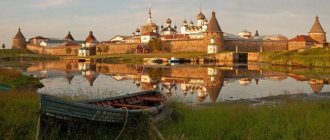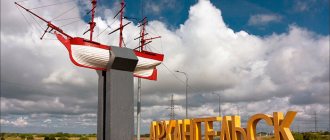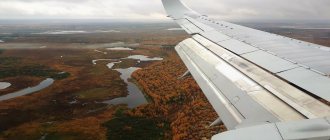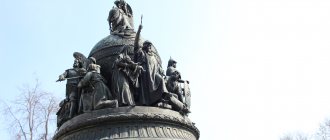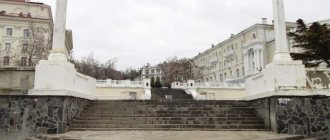HomeTourists Weekend in Russia
Arkhangelsk was called the “Capital of the North”, “Gateway of the Arctic”, and now this city - the first seaport of Russia - is officially classified as the land Arctic territory of Russia. What to see in Arkhangelsk and its surroundings on a classic weekend tour - read in the ATOR Bulletin.
Pedestrian street – Chumbarova-Luchinsky Avenue
Local residents affectionately call the pedestrian avenue Chumbarov-Luchinsky Chumbarovka - this is the next attraction of Arkhangelsk, popular not only among tourists, but also among local residents.
Previously, Chumbarovka was called Sredny Avenue, then Bolshaya Meshchanskaya Street, Pskov Street, and since 1921 it has been named after Fyodor Stepanovich Chumbarov-Luchinsky, a revolutionary figure, poet and publicist during the Civil War.
Arkhangelsk Arbat starts at the Central Market and ends at Lenin Square. The length of the street is slightly more than 1 km. By the way, the market can also be classified as an attraction, because this is where you can buy sea fish or meat from northern animals, prepared according to local recipes.
In the 90s of the last century, using photographs and drawings on a pedestrian street, they began to recreate old wooden houses scattered throughout various corners of Arkhangelsk. At the same time, many of the originals continue to stand in disrepair in their original places, and their doubles adorn the pedestrian street. There are only two real dismantled and transported houses on Chumbarovka.
Gradually, the street became overgrown with historical and architectural monuments and turned into a museum street.
For a quick walk along Chumbarova-Luchinsky Avenue, 15 minutes is enough. But for a more detailed inspection, it’s worth dedicating at least half an hour to an hour to this street!
Residential building, a monument of history and architecture, built in 1872 - Ananyeva's house . Built on a pedestrian street in 1990.
Address: Chumbarova-Luchinsky Ave., 15
The estate of M. T. Kunitsyna - now the estate houses a museum that tells the history of the house and its owners. The ticket price is symbolic - 100 rubles. The original estate was built at the turn of the 19th and 20th centuries, and was recreated on a pedestrian street at the beginning of the 21st century.
Address: Chumbarova-Luchinsky Ave., 17
The two-story blue house with a corner turret is a modern copy of the house of lawyer N.V. Nikolsky, built in 1913. The original is located on Sovetskikh Kosmonavtov Avenue, 79.
Address: Chumbarova-Luchinsky Ave., 19
The brick city estate of F. G. Antonov , built in 1914, is the only real old-timer on this street. It is a monument of urban planning and architecture of regional significance.
Address: Chumbarova-Luchinsky Ave., 20
The most elegant house on the pedestrian street is the wooden carved house of A. S. Chudinov, built in 1904. Initially, the house stood on the Northern Dvina embankment. The house was dismantled, transported to Chumbarovka and reassembled. Now this beautiful house has several shops, cafeterias and a tourist center nearby.
Address: Chumbarova-Luchinsky Ave., 30
In the house opposite there is a museum and workshop “Arkhangelsk Gingerbread”.
Address: Chumbarova-Luchinsky Ave., 37
Arkhangelsk gingerbreads are called kozuli . They are made using burnt sugar, which gives the dough a dark color, and are painted with white icing. Northern roe deer have been made since the 12th century: the dough was rolled out into a thin rope, which was then twisted and curled into different patterns or animals. This is where the name “roe” comes from, which from the Pomeranian language means “snake, curl.” Gingerbread cookies were used in fortune telling, as amulets and as gifts.
Marfin House (also known as the House of the Commercial Assembly) was built in 1857 for a meeting of Arkhangelsk merchants. This is another original that was dismantled and moved, which stood on Trinity Avenue until 1987.
Address: Chumbarova-Luchinsky Ave., 38
The house of S.V. Ovchinnikov is also a copy. The original, built in 1912, is located on Voskresenskaya Street, 37.
Address: Chumbarova-Luchinsky Ave., 48
I bet that many tourists coming to Arkhangelsk do not even suspect that the pedestrian street is completely lined with replicas of ancient houses.
The attractions of Chumbarovka include not only wooden houses, but also several modern monuments and sculptures.
Near the Kunitsyna estate there is a sculpture “Russian wives - guardians of the family hearth.”
And near Chudinov’s house there is a monument to the “Arkhangelsk peasant” in the image of the hero of the story about “Burbot Malinich”, who sits astride a huge fish. The author of this story and many other Pomeranian tales is the storyteller Stepan Grigorievich Pisakhov.
By the way, near the Arkhangelsk peasant you can also find a monument to the author of the fairy tale. Stepan Grironevich Pisakhov lived not far from the current pedestrian street. Pisakhov's tales glorified the North in the same way as Bazhov's tales glorified the Urals.
On the other side of the Arkhangelsk peasant, there is another monument to the Pomeranian storyteller - the monument to Boris Shergin. Despite the fact that Shergin lived most of his life in Moscow, in his work one can find many stories and epics dedicated to Arakhngelsk.
Interesting cartoons were made based on the fairy tales of Pisakhov and Shergin: Laughter and grief at the White Sea (1988), The Magic Ring (1979), Martynko (1987), Mister Pronka (1991).
Natural attractions
The climate of Arkhangelsk is harsh, but there are still plenty of natural attractions here. Most of the interesting objects are located outside the city, and within its boundaries, especially in summer, it is worth exploring the green parks and squares.
Petrovsky Park
Before the revolution, this place was called Lomonosov Meadow, then - Gagarin Garden. The city park was laid out back in 1868, and 150 years later it was landscaped and decorated with fountains.
On the territory there is a walking area with shady alleys, benches and a children's playground, separated from the main Lenin Square by the Drama Theater building. The promenade stretches along the developed bank of the Northern Dvina River. In this area there is one of the oldest fountains in the city, where newlyweds often come to take photos.
Various festivals are regularly held in the park: book, art, creative industries, etc.
Arboretum of Northern (Arctic) Federal University
The object of historical, cultural and natural heritage is a division of the Northern Arctic Federal University. The introduction point has existed since 1934 and is considered one of the oldest in the European North.
Here, on an area of 1.6 hectares, more than 200 species of plants from Central Asia, North America, and Central Europe are presented. Perennial flowers, various shrubs and trees are cultivated. The most common are honeysuckle, lilac, apple tree, and hawthorn. Many of them bloom and attract lovers of colorful photo shoots in the summer.
The arboretum has been improved: it is looked after by university student interns. There are tiled paths for walking.
Group excursions are organized at the Arboretum. They are held every day from 8:00 to 16:15.
Literary Square
Opposite the Literary Museum, on Chumbarova-Luchinsky Avenue, a square of the same name was opened in 2021. The entrance to the reading corner is decorated with bronze sculptures. On the creative site, along the tiled paths, there are benches for guests, urns and flower beds.
At the bookcrossing point there is a telephone booth with a restored payphone from the second half of the 20th century. Anyone can take a book of interest from a special bookcase and put another one in its place.
Talented poets and writers perform on the improvised stage of the art space, and connoisseurs of literature and the Russian language come to listen to their readings. The park hosts thematic competitions, master classes and festivals.
Obelisk “To the Victims of the Intervention of 1918-1920” (Mass Graves)
The monument was built in 1950 on the V.I. Lenin embankment in the alignment of the street. K. Liebknecht, at the site of the solemn burial of the ashes of fighters who died in the fight against the interventionists and White Guards in the North.
Bolshevik underground fighters who were shot by interventionists and White Guards on the night of May 1, 1919 on Moss are buried in the Mass Graves. R.P. Kulikov, a member of the All-Russian Central Executive Committee, commissar of the Arkhangelsk division, secretary of the Arkhangelsk organization of the RCP (b), who died in reconnaissance on the night of July 18, 1918 in the Solza area, as well as the commander of the icebreaker “Svyatogor” N, was also buried here. A. Dreyer, chairman of the ship committee of this ship A. A. Terekhin, commissioner of the Arkhangelsk city police M. A. Valyavkin, chairman of the trade union of sawmill workers N. V. Levachev and others.
The monument was built from reinforced concrete, gray granite, bronze and cast iron. Its base is a square three-stage platform, at the corners of which there are quadrangular elevations. A bronze plaque with the image of bowed Red Banners, laurel and oak branches is mounted into the front face of the pedestal. On the other three faces of the pedestal there are cast-iron memorial plaques listing the names of those buried. The upper part of the monument is a tetrahedral pillar, tapering upward. The total height of the obelisk is 10.85 meters.
St. Nicholas Church
The temple stands in the city center near the Embankment. The cross on the golden dome is visible from afar. It is almost always sunny inside the temple because the altar faces south and not east. The main bell weighs 530 kg.
St. Nicholas Church
Initially it was the Nikolo-Korelsky monastery, which was founded by the monk Euthymius in the 15th century. In 1598, the Nikolo-Korelsky courtyard began to be created. In addition to the temple itself, it included three more buildings. St. Nicholas Church was closed in February 1930. Its revival began only in 1992.
- Where is it: Northern Dvina embankment, 74.
- Opening hours: daily from 8:00 to 19:00.
- Cost of visiting: free.
Monument to M.V. Lomonosov
The monument was created in 1826 - 1829 by the outstanding Russian sculptor I.P. Martos. The author portrayed M.V. Lomonosov "standing on the northern hemisphere... and looking at the majestic celestial phenomenon (the northern lights) with delight and surprise." The name Kholmogor is engraved on the hemisphere. The winged genius, kneeling at the feet of the poet, hands him the lyre.
The total height of the monument is eight meters: the bronze sculpture of M.V. Lomonosov is about two meters, the cylindrical polished base of pink Finnish granite is more than three meters and the square base covered with dark marble chips is more than two meters.
The monument was installed in front of the main facade of the building of the Arkhangelsk Forestry Institute. The monument was originally erected on Cathedral Square and inaugurated on June 25, 1832. This was the first monument to perpetuate the name of the father of Russian science (not counting the tombstone on the grave). The initiators of the creation of the monument were the residents of Arkhangelsk. Funds were collected through all-Russian subscription. In 1867, the monument was moved to the square in front of the provincial government buildings. It was installed at its current location in 1930-1932.
Lenin Square and Arkhangelsk street art
Despite the desertion, Lenin Square is the main square of Arkhangelsk. This place has been central since ancient times: the Church of the Resurrection, the governor’s house, and the building of the City Duma were located here. Later, all these historical objects were demolished from 1963 to 1973. a new square was formed with the appearance as we know it today.
The dominant feature of Lenin Square is the Arkhangelsk skyscraper - this is not only a landmark of the city, but also its calling card. It appears in every guidebook, in every set of postcards and photographs.
The design organization building (this is the name of the tallest 24-story building in Arkhangelsk) has a height of 82 m to the roof, and 142 m to the tip of the spire. The high-rise was built in 1975-1977. on the site of a merchant mansion.
Address: pl. Lenina, 4
Lenin himself had never been to Arkhangelsk, but for some reason he really disliked this city, like the entire Russian North: “Everything north of Vologda is savagery, semi-savagery and real savagery.” And yet, in 1988, a massive figure of Vladimir Ilyich appeared on the central square of Arkhangelsk.
The long house on legs houses the Local History Museum and the Museum of Fine Arts.
Address: pl. Lenina, 2
Since 2014, the Museum of Fine Arts has provided its walls for creativity to contemporary street artists. Since then, another attraction has appeared in Arkhangelsk - a street “art gallery”, where replicas of famous artists are depicted with the addition of a new interpretation.
Copy of Kuzma Petrov-Vodkin’s painting “Bathing the Red Horse”:
Copy of Marc Zakharovich Chagall’s painting “Above the City”:
Copy of Salvador Dali's painting "Madonna of Port Lligat":
Copy of Rene Magritte's painting "Son of Man":
Copy of Edvard Munch's painting "The Scream":
Copy of Gustav Klimt's painting "The Kiss":
Copy of Yuri Pimenov’s painting “Thinking Girl”:
Monument to the Victims of the Intervention of 1918-1920
The monument was opened in 1958 at the Kuznechevsky (Vologda, Lutheran, German) cemetery, at the site of the execution of the leaders of the Bolshevik underground in Arkhangelsk by interventionists and White Guards on the night of May 1, 1919. Among those executed were K. I. Tesnanov, D. P. Anisimov, K. N. Bliznina, D. A. Prokashev, S. A. Zakemovsky, Ya. Yu. Rosenberg, F. E. Antyn and others - 11 people in total .
A group of dead comrades is depicted in life-size against the backdrop of an unfurled Red Banner at the moment before the execution. In the center of the group is K. I. Tesnanov, who had the highest stature among the underground fighters. He raised his head proudly and tore his shirt off his chest. Second from the right is K.N. Bliznina, the only woman among the underground fighters. She supports the weak, fulfilling her duty as a sister of mercy to the end.
The sculptural group cast from bronze is mounted into a wall made of gray granite. On the left, in the granite wall, there is a memorial plaque with explanatory text, on the right - a symbolic image of the eternal flame. The memorial plaque reads: “Immortality and glory to the heroes - the unbending fighters for Soviet power and the independence of our Motherland.”
This is the best historical and revolutionary monument in Arkhangelsk. Artistic casting and granite processing were carried out by specialists from the Mytishchi Art Casting Plant. The authors of the monument are sculptor M. S. Aleshchenko and architect M. D. Nasekin.
Monument to Pavlin Vinogradov
The monument to the hero of the civil war in the North, Pavlin Fedorovich Vinogradov (1890 - 1918), was opened on November 5, 1960 on the square in front of the Mir cinema. The total height of the monument is 8 meters. The pedestal is made of brick and lined with blocks of polished pink granite. On the front side of the pedestal is inscribed: Pavlin Fedorovich Vinogradov 1890 - 1918. Below the explanatory inscription there is a cartouche - a bronze bas-relief decoration with the image of a bowed Red Banner, against the background of which appear a shield, an anchor with a chain, a five-pointed star, oak and laurel branches, symbolizing naval military valor and the immortality of the feat accomplished by P.F. Vinogradov.
The figure of P.F. Vinogradov was cast from bronze at the Mytishchi Art Casting Plant. Granite blocks were also made there. The authors of the monument are sculptor M.S. Aleshchenko and architect M.D. Nasekin.
Church of Saint Martin the Confessor
The temple was founded in 1803, and consecrated in 1806. The construction was led by architect Pyotr Kharlov. Until 1886, the church belonged to the Solombala Cathedral, and only then did it gain independence.
Church of Saint Martin the Confessor
Many famous personalities of Arkhangelsk constantly donated money to the temple. Among them are the shipowners Makarovs and the merchant Dmitry Pochinkov (it was thanks to him that the semicircular gilded iconostasis and stone floor were built). The Temple of Martin the Confessor was never closed, unlike other churches in the city.
- Where is it: Terekhin Street, 75.
- Opening hours: daily from 8:00 to 19:00.
- Cost of visiting : free.
Obelisk of the North
Erected in honor of the creation of the Northern Territory in front of the House of Soviets along the avenue and under the direction of the sculptor I.K. Altukhov. The resolution to install the monument was adopted on August 19, 1929 by the 1st Regional Congress of Soviets, and the grand opening of the obelisk took place on November 7, 1930.
The pentagonal pedestal of the monument is decorated with bas-reliefs reflecting the main directions in the development of the national economy of the North: logging, sawmilling, fishing, dairy farming and reindeer husbandry. Above it rises a sculptural image of a Pomor with a reindeer, and there are also memorial plaques with explanatory texts. “Obelisk of the North” has long become the emblem of Arkhangelsk. His image can often be seen on postal envelopes, advertisements, posters, etc.
Attractions for children
The main attractions of Arkhangelsk for children are theaters, zoo corners and amusement parks.
Puppet Theatre
The modern building of the puppet theater has stood on Trinity Avenue since 1938. The three-story house was created in the spirit of Stalinist classicism. The decor on the beige facade includes stucco molding located between two windows at different levels. In the center there is a superstructure at the third floor level.
The theater's repertoire consists of productions for people of all ages, including children. More than 40 successful performances are staged here and some of them are aimed at adult audiences.
In addition to performances, the puppet theater hosts creative evenings, seminars, excursions, lectures and master classes.
Santa Claus Village
The project was created in 1989 as the official residence of the Russian Father Frost. The patrimony of the fairy-tale character is located on the banks of the Solombala River. The architectural and park complex is open all year round, but is especially active in winter.
During the tour of the “frosty village”, guests are invited to send a letter to the New Year's gift giver to the address of the grandfather's post office house. And you can attend an official reception with Father Frost himself.
On the territory of the village there is another wooden house in which there is a manufacturing shop. Nearby there is a celebration glade with snow sculptures. During the visit, guests are invited to ride a sleigh, dance around the beautiful Christmas tree and drink hot tea.
Mini-zoo "Madagascar"
The zoo is located on the 3rd and 4th floors of the shopping and entertainment center and looks like a tropical corner. The living collection includes exotic birds, mammals and reptiles. The hall features parrots, small goats, hedgehogs, rabbits, monkeys, turtles, kangaroos and even a crocodile.
Each animal is allowed to have contact and be photographed. You can feed the monkeys bananas and carrots, and hold the parrots in your arms. Individual and group excursions are available around the zoological park.
Amusement park "Poteshny Dvor"
The seasonal park with more than 20 attractions is the main place for family and youth recreation in the city in the summer. Entertainment for adults and children is available on site. The most popular among them was the Ferris wheel, which serves as an excellent viewing platform.
Carousels, trampolines, trains, and swings are available for kids. The cheapest attractions are “Yunga”, “Octopus”, “Flight of Fancy”, “Cups”, “Indian River”. On some of them, children under 1 year old can ride for free when accompanied by an adult.
Northern Dvina embankment
The Northern Dvina embankment is one of the most important and longest streets in Arkhangelsk. The embankment begins near the Severdvinsky Bridge and ends 7 km later near the Kuznechevsky Bridge. However, the tourist and walking area with sightseeing is slightly less than half of the entire length of the street - about 3 km.
During its existence, the embankment has changed many names. Until 1935, it was divided into several parts with the names Torgovaya Embankment and Petrovsky Boulevard. Since 1935, the embankment was called Stalin's Udarnikov Avenue. Since 1946 - Stalin embankment. Since 1961 - Lenin embankment. The embankment received its current name in 1993.
Let's start our walk along the embankment at the Marine and River Station, which appeared on this site in 1972. The Arkhangelsk Marine and River Station because it is depicted on the 500-ruble banknote.
Address: emb. Northern Dvina, 26
Near the station there are several piers where you can see moored ships at any time of the year. You won't be able to get closer to them and take a photo against the background, because... All berths are surrounded by a fence.
St. Michael the Archangel Cathedral , the construction of which began in 2008, rises right there
A long time ago in the 12th century, the Archangel Michael Monastery was founded not far from this place. He is the great-grandfather of modern Arkhangelsk. When in 1583 Ivan the Terrible gave the order to erect a city on the Dvina for protection from Sweden, within a year a wooden fortress was built around the monastery, called Novokholmogory. This is how the history of Arkhangelsk began, the name of which they decided to borrow from the monastery.
Over its centuries-old history, the monastery was burned and destroyed several times, but each time it was rebuilt. In 1685-1689. A five-domed stone cathedral was built, which was the oldest temple in pre-revolutionary Arkhangelsk.
In 1930, the cathedral, bell tower and part of the fence with towers were dismantled. Later, other monastery buildings disappeared, and now the territory of the monastery is built up with residential buildings. Despite the fact that more than a dozen churches in Arkhangelsk were destroyed in Soviet times, the name of the city was not changed.
Across the road from the cathedral stands the house of shipowner Yakov Belyaevsky , built in 1907, built in a classic Arkhangelsk style with an overhanging bay window.
Address: st. Vyucheyskogo, 2
Belyaevsky had another luxurious wooden house in the Art Nouveau style, but it was demolished in the early 70s.
A little ahead you can see a three-story brick building - this is the courtyard of the Sursky Monastery . The building was built in 1905-1907. in the Russian-Byzantine stele and was originally decorated with three domes, which laconically completed the structure. Unfortunately, the chapters have not survived to this day.
Address: emb. Northern Dvina, 47
And now let's admire the architecture of Arkhangelsk of the 21st century . The next 500 meters of the embankment are built up with new residential complexes. There is only one thing beautiful about these plastic houses - the panoramic view from the window of the Northern Dvina.
It looks like the architect (if there ever was one) took inspiration from the Soviet-era houses on Lenin Square.
House on the embankment built in 2021
House on Lenin Square built in 1974
Since we have returned to the USSR, here is the Palace of Children and Youth Creativity - the former Palace of Pioneers , built in 1980 with an observatory tower.
Address: emb. Northern Dvina, 73
There are piers near the shore and you can admire sea and river vessels peacefully resting through the fence. Arkhangelsk is still one of the largest seaports in North-West Russia, which is why the city has become an important scientific center since the end of the 19th century. It is from here that scientific expeditions set off to explore the cold Arctic start.
Nearby, by some miracle, two entire blocks of the historical buildings of Arkhangelsk from the 18th century have been preserved.
Construction of the Shingarev-Plotnikov city estate began in 1794, when the house had two owners. Since 1894, when Pavel Mikhailovna Shingareva became the only owner, the reconstruction of the house began. The building received its current appearance at the beginning of the 20th century, when Ekaterina Kirillovna Plotnikova became its owner. The estate complex included a power station, a carriage house and a trading house. Now the building houses a museum with exhibitions of interiors and paintings.
Address: emb. Northern Dvina, 72
The small St. Nicholas Church is perhaps the most striking among all the churches in Arkhangelsk. It was built in 1904 with a stylistic reference to the era of Russian pattern making of the 17th century.
Address: Teatralny Lane, 3
To the left of St. Nicholas Church there are trading buildings built in 1844, and the street at that time was called Torgovaya.
Address: emb. Northern Dvina, 75
The same view from the early 20th century. The right row of houses no longer exists, but the left row has been preserved almost in its original form.
Former Torgovaya Street in Arkhangelsk of the 20th century.
The white two-story corner building, attached to the left of the commercial buildings, is a former commercial bank . In 1786, merchant Yakov Vaganov built a two-story brick house on Torgovaya Street. This was one of the first brick houses on this street. After the death of the owner, a commercial bank bought the house from the heirs and in 1821 opened its branch there, which operated for almost a hundred years.
Address: emb. Northern Dvina, 76
The small, prominent building in the center of the historic quarter was actually a commercial bank. Nowadays, children's music school No. 1 is located here - the oldest in Arkhangelsk.
Address: emb. Northern Dvina, 76
The next historical quarter is almost completely occupied by the courtyard of the Solovetsky Monastery, which appeared on this site in the 17th century. The courtyard includes trade, hotel and utility buildings, and the dominant feature is the church of St. Zosima, Savvaty and Herman . The ornate church appeared on the site of a rebuilt trading store in 1898.
Address: emb. Northern Dvina, 77
Since 1786, a post office . There is no post office here now, but there is a restaurant of the same name.
Address: emb. Northern Dvina, 78
This ends Arkhangelsk of the 18th century, and we again move to the Soviet Union.
The Lomonosov Drama Theater was built in 1931 on the foundation of the dismantled Holy Trinity Cathedral of the early 18th century. Petrovsky Park is located around the drama theater.
With its facade, the theater “looks” at a huge building with columns in the Stalinist Empire style. Year of construction: 1953.
Further along the embankment we see a monument to Peter I against the background of the city school, built in 1901-1906.
Feeling a special attraction to the sea, Peter I visited Arkhangelsk three times (in 1693, 1694, 1702). According to his decrees, a large shipyard and a defensive Novo-Dvina fortress were built. However, after the founding of St. Petersburg in 1703, Peter's passions in Arkhangelsk subsided. Moreover, Peter I even introduced strict restrictions on trade through the port of Arkhangelsk, which were lifted only in 1762. After such a long lull, the city was never able to fully recover and restore its previous position.
The life-size monument was erected in 1914. It is a copy of monuments from St. Petersburg, Shlisselburg and Taganrog. The monument is also depicted on the 500-ruble banknote.
Cape Pur-Navolok is one of the main attractions of Arkhangelsk. It was on this spot that the ancient St. Michael the Archangel Monastery stood, and it was here that a wooden fortress was erected in 1584 by order of Ivan the Terrible. The place, filled with such important events for Arkhangelsk, is now decorated with a granite “bow of the boat” and a compass mounted on top.
There is also another valuable attraction here - the Arkhangelsk Gostiny Dvors, or rather the preserved fragment of the western wall and the northern tower.
Address: emb. Northern Dvina, 86
After the Soviet authorities demolished all the pre-Petrine churches in the city, Gostiny Dvor became the oldest building in Arkhangelsk. Date of construction: 1668-1684. Now the building is occupied by a local history museum.
Walking along the Northern Dvina embankment, in addition to historical buildings, it is worth paying attention to various monuments, most of them dedicated to military themes.
Monument to participants of the Northern convoys of 1941-1945. , and behind it across the road is the eternal flame and the obelisk to the heroes of the Soviet Union .
Monument to the seal . During the Great Patriotic War, Arkhangelsk was the second (after Leningrad) city in the USSR in the number of deaths from starvation, even though thousands of tons of food passed through its port. Fishing expeditions were organized to hunt seals in the White and Barents Seas. The obtained meat, fat and skins of northern animals saved thousands of needy people from starvation and cold not only in Arkhangelsk and nearby areas, but also in Leningrad. In addition, seal oil was used to lubricate guns on ships of the Northern Fleet.
Monument to the Solovetsky cabin boys , erected in memory of all the young cabin boys who died during the Second World War.
At any time of the year, the embankment is very lively: in the summer residents go to the beach, in the winter they go ice skating and tubing.
And in winter, wooden paths are laid across the Northern Dvina - these are pedestrian crossings on the ice to neighboring banks and islands.
Turning from the embankment onto Karl Marx Street, we see the former Lutheran Church of St. Catherine . The church was built in 1786 for foreign merchants. The building, albeit with modifications, has survived to this day, but now it houses the Pomeranian Philharmonic.
Address: st. Karl Marx, 3
The house of A. Yu. Surkov was built on the Northern Dvina embankment in 1851. The successful merchant of the 1st guild, industrialist and public figure Albert Yulievich Surkov was so wealthy that he allowed himself to decorate the entire house with carvings and various decorations, and not just the facade!
In 1991, due to its dilapidated condition, the house was completely dismantled and rebuilt.
Address: st. Popova, 1
Behind the house, the Surkov Brewery of 1883-1913 has been preserved. the buildings. The plant complex consists of three stone buildings - a non-alcoholic workshop, a brewhouse and the main building. There are also many small buildings. Architects call the plant a monument of the eclectic period, combining elements of rationalism and Art Nouveau style. Currently, the premises of the former brewery are not used and are in disrepair.
Address: st. Popova, 3
We finish our walk along the Northern Dvina embankment near the Assumption Church . The first wooden church on this site was erected in 1626. In the 1740s. The wooden church, which had fallen into disrepair, was rebuilt into a stone one. In 1752, a high multi-tiered stone bell tower was added to the church, which also served as a lighthouse for ships arriving in Arkhangelsk. In the 1930s the temple and bell tower were demolished. Rebuilt in 2008.
Address: st. Loginova, 1
In 2009, a monument to Peter and Fevronia .
Malye Korely Museum
You can’t come to Arkhangelsk and not visit the museum of wooden architecture and folk art of the northern regions of Russia - Malye Korely .
The Malye Korely open-air museum is located outside the city near the village of Malye Karely, however, you can easily get there from Arkhangelsk by public transport.
The museum covers an area of about 140 hectares, its holdings include about 120 civil, public and church buildings, the earliest of which date back to the 16th century. Among the exhibits are peasant and merchant huts, barns, wells, fences, windmills, baths, etc.
Malye Korely is one huge attraction, and it is better to set aside a separate day to explore it.

